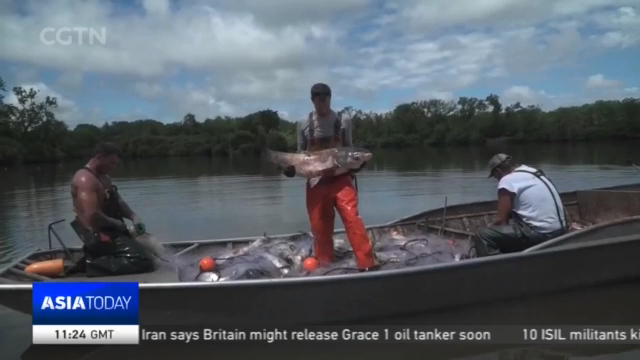
19:48, 13-Aug-2019
Invasive Species: Carp pose 'ecological threat' to Great Lakes area
Updated
20:07, 13-Aug-2019

The Great Lakes that straddle the U.S.-Canada border, cover the largest area of fresh water in the world. Tourism in the region is worth billions of dollars. But the area faces a major ecological threat. Asian carp have invaded rivers further inland. And there are fears they could soon reach the Great Lakes. CGTN's Dan Williams reports in our series about invasive species.
On the Illinois River, fishermen don't just hope to catch some fish, it's more a question of how many.
These are predominantly silver and bighead carp, the most worrisome species of invasive Asian carp.
Initially brought to Arkansas in the 1960s as a way to control aquatic weeds, the carp spread during flooding in the 1990s.
The carp quickly conquered river systems, stealing the food supply from other species and are now posing a threat to the Great Lakes.
KEVIN IRONS PROGRAM MANAGER, AQUATIC NUISANCE SPECIES ILLINOIS DEPARTMENT OF NATURAL RESOURCES "If we see the effects here in our rivers where they are competing for food, we are likely to see the same thing if they are able to establish populations in the Great Lakes."
But local authorities are fighting back employing fishermen to remove as many carp as possible.
DAN WILLIAMS ILLINOIS RIVER "Well on any given day, these fishermen can take away some five thousand carp from this river. As you can see, there is plenty more where they came from."
Shawn Price is among the commercial fishermen who have been contracted by the state.
SHAWN PRICE FISHERMAN "Obviously these fish are very smart. The net actually moves fish as much as boats do, they know they are there and they start heading for the door. We are trying to be part of the solution, and so far, we are the solution."
For now, the carp are simply given away, picked up by businesses that use them for fertilizers, fish oil and pet treats.
A single female can lay up to two million eggs a year but this process appears to be having results.
KEVIN IRONS PROGRAM MANAGER, AQUATIC NUISANCE SPECIES ILLINOIS DEPARTMENT OF NATURAL RESOURCES "We are over eight million pounds removed from the Illinois River. This year in 2019, we are already about half a million pounds. The leading edge, which is about Dresden island pool, because of these efforts, the population there is down by 96% due to the removal efforts like you saw today."
But the risk to the Great Lakes remains. Two years ago, a lone silver carp was found about 15 kilometers from Lake Michigan.
In response, a 778 million dollar U.S. Army Corps of Engineers plan to upgrade this lock has just been approved.
Once completed, the lock will include new devices such as noisemakers, air bubbles and electric barriers. All in an effort to stop the carp from entering the Great Lakes.
JOEL BRAMMEIER PRESIDENT & CEO, ALLIANCE FOR THE GREAT LAKES "In the Great Lakes, a part of the regional economy is based on tourism. It is based on boating and fishing and the carp is an existential threat to those industries. So if we don't stop them reaching the Great Lakes region, we are going to completely upend the way that ecosystem functions. And of course, all the human systems that rely on and enjoy those systems every day."
What happens if the carp become established in the Great Lakes?
They could overtake the native fish and threaten the seven billion dollar fishing and recreation industry.
Dan Williams, CGTN, Starved Rock, Illinois.
SITEMAP
Copyright © 2018 CGTN. Beijing ICP prepared NO.16065310-3
Copyright © 2018 CGTN. Beijing ICP prepared NO.16065310-3